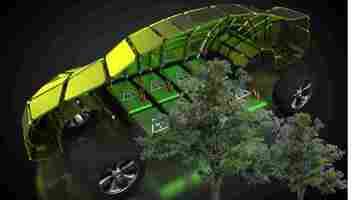Forget AI and 5G, it’s low-tech solutions that will help our planet
It’s a popular idea that the path to sustainability lies in high-tech solutions. By making everyday items like cars electric , and installing smart systems to monitor and reduce energy use, it seems we’ll still be able to enjoy the comforts to which we’ve become accustomed while doing our bit for the planet – a state known as “ green growth ”.

But the risks of this approach are becoming ever clearer. Many modern technologies use materials like copper, cobalt, lithium and rare earth elements. These metals are in devices like cell phones, televisions, and motors. Not only is their supply finite, but large amounts of energy are required for their extraction and processing – producing significant emissions.
Plus, many of these devices are inherently difficult to recycle. This is because to make them, complex mixes of materials are created, often in very small quantities. It’s very expensive to collect and separate them for recycling.
Among others, these limitations have led some to question the high-tech direction our society is taking – and to develop a burgeoning interest in low-tech solutions . These solutions prioritize simplicity and durability, local manufacture, as well as traditional or ancient techniques.
What’s more, low-tech solutions often focus on conviviality. This involves encouraging social connections, for example through communal music or dance , rather than fostering the hyper-individualism encouraged by resource-hungry digital devices.
“Low-tech” does not mean a return to medieval ways of living. But it does demand more discernment in our choice of technologies – and consideration of their disadvantages.
Origins of low-tech
Critics have proclaimed the downsides of excessive technology for centuries, from 19th century Luddites to 20th-century writers like Jacques Ellul and Lewis Mumford. But it was the western energy crisis in the 1970s that really popularised these ideas.
British economist E.F. Schumacher’s 1973 book Small is Beautiful presented a powerful critique of modern technology and its depletion of resources like fossil fuels . Instead, Schumacher advocated for simplicity: locally affordable, efficient technologies (which he termed “intermediate” technologies), like small hydroelectricity devices used by rural communities.
Schumacher’s mantle has been taken up by a growing movement calling itself “low-tech”. Belgian writer Kris de Dekker’s online Low-Tech Magazine has been cataloging low-tech solutions, such as windmills that use friction to heat buildings, since 2007. In particular, the magazine explores obsolete technologies that could still contribute to a sustainable society: like fruit walls used in the 1600s to create local, warm microclimates for growing Mediterranean fruits.
In the US, architect, and academic Julia Watson’s book Lo-TEK (where TEK stands for Traditional Ecological Knowledge) explores traditional technologies from using reeds as building materials to creating wetlands for wastewater treatment.
And in France, engineer Philippe Bihouix’s realization of technology’s drain on resources led to his prize-winning book The Age of Low Tech . First published in 2014, it describes what life in a low-tech world might be like, including radically cutting consumption .
Bihouix presents seven “commandments” of the low-tech movement. Among others, these cover the need to balance a technology’s performance with its environmental impact, being cautious of automation (especially where employment is replaced by increased energy use), and reducing our demands on nature.
But the first principle of low-tech is its emphasis on sobriety: avoiding excessive or frivolous consumption, and being satisfied by less beautiful models with lower performance. As Bihouix writes:
Ancient solutions
Crucially, we can apply low-tech principles to our daily lives now. For example, we can easily reduce energy demand from heating by using warm clothes and blankets. Food, if it’s packaged at all, can be bought and stored in reusable, recyclable packaging like glass.
Architecture offers multiple opportunities for low-tech approaches, especially if we learn from history. Using ancient windcatcher towers designed to allow external cool air to flow through rooms lets buildings be cooled using much less energy than air conditioning. And storing heat in stones, used by the Romans for underfloor heating , is being considered today as a means of dealing with the intermittency of renewable energy.
Design and manufacture for sustainability emphasize reducing waste, often through avoiding mixing and contaminating materials. Simple materials like plain carbon steels, joined using removable fasteners, are easy to recycle and locally repair. Buses, trains, and farm machinery using these steels, for example, can be much more readily refurbished or recycled than modern cars full of microelectronics and manufactured from sophisticated alloys.
In some places, the principles of low tech are already influencing urban design and industrial policy. Examples include “ 15-minute cities ” where shops and other amenities are easily accessible to residents, using cargo bikes instead of cars or vans for deliveries, and encouraging repairable products through right-to-repair legislation in the EU and US.
Meanwhile, in Japan, there’s emerging interest in the reuse and recycling practices of the Edo period . From 1603 to 1867, the country was effectively closed to the outside world, with very limited access to raw materials. Therefore, extensive reuse and repair – even of things such as broken pottery or utensils with holes that we’d now regard as waste – became a way of life. Specialist repairers would mend or recycle everything from paper lanterns and books to shoes, pans, umbrellas, and candles.
By following examples like these, we can make discerning technological choices a central part of our search for sustainable ways of living.
This article by Chris McMahon , Senior Research Fellow in Engineering, University of Bristol is republished from The Conversation under a Creative Commons license. Read the original article .
This company thinks wood pulp could be the future of EV batteries
Japanese Nippon Paper Industries Co. is examining how to replace EV lithium-ion batteries by using… trees, reports Bloomberg .

The company wants to create supercapacitors that will use cellulose nanofibers, which are produced from wood-derived pulp, and refined to the size of hundredths of a micron or smaller.
As per Nippon Paper, such supercapacitors could potentially store and release energy with better performance and smaller environmental impact, compared to existing batteries.
Well, on the one hand it’s true that supercapacitors have been already considered as a viable alternative to lithium-ion batteries.
They have a higher power density, which means they can release energy more quickly, a longer life span, faster charging times, and they don’t degrade over time.
On the other hand, they have only but a tiny bit of the storage capacity of a battery. And that’s exactly what Nippon Paper’s project plans to fix.
In a paper published in March, a team of collaborating scientists offered evidence that supercapacitors using cellulose nanofiber technology could store large amounts of energy.
Perhaps it’s just me, but I can’t easily grasp how a technology that is currently used in products such as diapers and food additives could actually become the next-gen powertrain of electric vehicles.
For anyone curious about it, a cellulose nanofiber pilot energy storage system will be demonstrated at the World Expo in Osaka in 2025, while the firm aims to commercialize its product by the following decade.
Do EVs excite your electrons? Do ebikes get your wheels spinning? Do self-driving cars get you all charged up?
Then you need the weekly SHIFT newsletter in your life. Click here to sign up .
What is Telematics and how can it make you a better driver?
This article was originally published by Martin Banks on Clean Fleet Report , a publication that gives its readers the information they need to move to cars and trucks with best fuel economy, including electric cars, fuel cells, plug-in hybrids, hybrids and advanced diesel and gasoline engines.

Internet of Things (IoT) technology is everywhere today, from the home to the office. One of the less familiar yet more exciting applications of IoT devices is in vehicles. One application of this technology, telematics, has seen rising popularity in both consumer and commercial circles–and it’s easy to see why.
Telematics covers a broad spectrum of technologies, from GPS navigation to IoT-enabled maintenance computers. Now, you can find all of these features on a single device, sometimes built into the vehicle itself. With the telematics market poised to reach $103 billion by 2022 , the benefits of these technologies are increasingly evident.


Here are a few ways telematics can help you become a better driver.
The first and perhaps most impactful way telematics make you a better driver is by revealing your driving patterns. These devices can show you data about how you accelerate, brake or make other choices. This information, in turn, will show your strengths and weaknesses as a driver, revealing a path to improvement.
This function is also the underlying idea behind usage-based insurance (UBI), which many insurers have now adopted. Progressive was the first to offer UBI programs , using GPS technology to provide mileage-based discounts. Now, these systems are more advanced, letting insurers offer discounted rates based on how and where you drive.
The promise of lower insurance rates offers a monetary incentive for better driving. When you know that insurers can see how you drive, you’ll be more likely to practice safe driving behaviors.
How you act on the road isn’t the only part of being a good driver. Keeping your vehicle in top condition matters, too, especially for commercial fleets that depend on their trucks making long trips.
More advanced telematics systems can monitor engine performance, fluid levels and other maintenance factors, revealing when you should tend to them.
Vehicles’ maintenance needs rarely fall along a regular schedule. New cars can go anywhere between 7,500 to 10,000 miles between oil changes, but this changes as they age. Telematics takes the guesswork out of the equation by showing precisely when a vehicle needs maintenance.
These services prevent costly breakdowns and keep vehicles in prime condition, providing improvements like higher fuel efficiency. Since fuel expenses account for the highest amount of operating cost waste , these benefits are especially valuable to fleets.
Perhaps the most straightforward way telematics can help you be a better driver is by getting you to your destination faster. GPS navigation is arguably the most familiar telematics use case, and one of the most helpful. As these systems become more advanced, they can consider more factors when planning routes, providing the best path for any circumstance.
Telematics systems enable other people to see a vehicle’s real-time position, too. This transparency lets fleets estimate and communicate delivery times while the same system optimizes drivers’ routes. These device networks can determine the best paths to deliver items in minimal time and with minimal fuel consumption.
This same technology is what enables ride-sharing apps like Uber and Lyft to work, too. Telematics through drivers’ phones can find the nearest available driver for any given passenger.
As environmental concerns grow, being a sustainable driver has become more critical. Telematics can help in this area, too, through the secondary impacts of their other features. When your car is in top condition and travels as efficiently as possible, its environmental impact will keep to a minimum.
Changing your oil regularly can improve mileage, as it takes less energy to move lower-viscosity fluids. Since telematics offers more accurate data about when you should change your oil, they prevent mileage-harming buildup. As a result, you end up using less fuel by producing fewer carbon emissions.
Route optimization also improves fuel economy by taking drivers along the most efficient paths. Sustainability may not be the primary goal of telematics, but it’s a beneficial side effect. As fleets face emissions regulations and drivers grow more concerned about the environment, these benefits become all the more valuable.
Whether you drive for a living or just in your personal life, becoming a better driver is a goal everyone should have. Better driving and vehicle care behaviors will make roads safer, more eco-friendly and affordable. There are many paths to this goal, but telematics is one of the easiest and most effective.
Telematics technology provides transparency and data-based decision-making in areas typically full of estimates and guesses. These devices are improving travel all around for both consumer and commercial markets.
Do EVs excite your electrons? Do ebikes get your wheels spinning? Do self-driving cars get you all charged up?
Then you need the weekly SHIFT newsletter in your life. Click here to sign up .